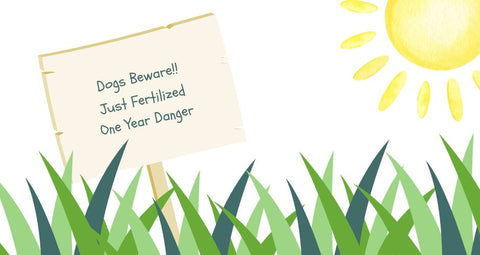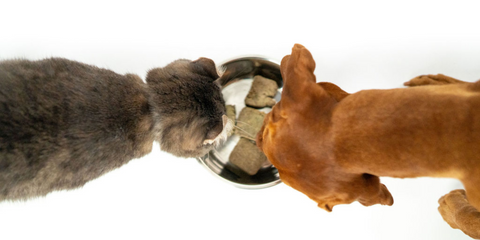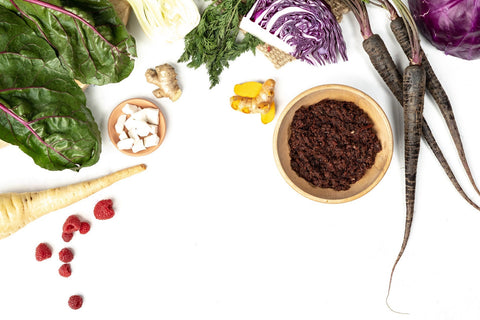By Dr. Keith Weingardt, DVM – Green Juju
When it comes to our pets, we want to do everything in our power to help them thrive. We keep them nourished, lively, and loved. But even the most attentive pet parents may not realize that one of the biggest threats to their pet’s long-term health is something they can’t see at all: glyphosate.
Glyphosate is the active ingredient in many herbicides, most notably Roundup, and it’s become one of the most widely used chemicals in conventional agriculture. It's also commonly used in lawn and garden care, where our pets love to play, sniff, and roll around in. Which means this toxin is now turning up in our pets at levels far higher than in humans, and that’s no small concern.
Why Glyphosate Is a Problem for Pets
Glyphosate has been shown to disrupt the endocrine system, an essential network that governs growth, metabolism, reproduction, and immunity. Research has linked it to increased cancer risk, hormonal imbalances, and gut microbiome damage. These are serious red flags for pet health, especially when we consider how high glyphosate exposure levels in pets actually are.
Recent data from Health Research Institute Laboratories (HRI Labs) revealed that:
-
Cats are averaging 8 parts per billion (ppb), 16 times more than humans
-
Dogs are averaging 15.8 ppb, 32 times the human average
-
Canned and kibble diets showed higher levels
-
Grain-free kibble had the highest levels, likely due to ingredients like oats, chickpeas, lentils, and pea protein
-
Dogs fed raw diets had virtually no detectable glyphosate
While more peer-reviewed research is underway, these findings paint a clear picture: diet matters. And so does your pet’s environment.
Where Glyphosate Hides
While processed foods made with genetically modified crops, especially those using legumes and grains, can be high in glyphosate residue, it’s not just food that's raising the alarms and toxin rates. Herbicides and weed killers used on parks, lawns, and gardens are major sources of environmental exposure when it comes to our pets.
If your dog flops onto a perfectly green, weed-free lawn and then licks their paws, that could be a glyphosate hit. As one local lawn sign served in a heartfelt but stern warning: “Just fertilized, one YEAR danger.”
And the scariest part is: these chemicals don’t just disappear. They can linger in the environment, and on your dog’s paws, for months.
What You Can Do to Reduce Risk
The good news? You can take simple, powerful steps to reduce your pet’s exposure and support their body’s natural detox processes.
1. Start With The Bowl
Choosing a clean, whole food diet is the best foundation you can give. Fresh, non-GMO, whole food diets, especially raw or gently cooked, help limit glyphosate exposure. If you feed kibble, go organic where possible. Grain-free diets with legumes and oats tend to carry higher levels of glyphosate.
2. Rethink Where They Play
Avoid recently treated lawns and parks. If exposure happens, rinse or wipe down paws. Little things like this make a big difference over time.
3. Support Detox Naturally
Your pet’s liver is their detox hero. Supporting it can help process and eliminate environmental toxins more efficiently. My go-to liver support options include:
-
Milk thistle seed
-
Dandelion root
-
Turmeric (like the kind in Lua’s Golden Paste)
-
Green Juju’s Bam’s Beets—rich in polyphenols to reduce oxidative stress and promote healthy bile flow
-
Green Juju’s Just Greens with dandelion is an excellent daily detox as dandelion stimulates the liver to excrete toxins
I also recommend:
Animal Essentials Liver Defense
ThorneVet Liver Support Formula
Adored Beast Apothecary Liver Tonic
When it comes to how long and how often, I like to cycle deeper detox support seasonally, with 4 to 6 weeks during key transitions like fall into winter and winter into spring. Whole food options like veggie blends and gentle herbal support can be used year-round for ongoing resilience.
4. Focus on Gut Health
Glyphosate harms the gut microbiome, but you can rebuild it. Rotating diverse probiotic strains helps promote resilience, restore balance, and improve immune function.
5. Consider Testing (in Certain Cases)
I don’t routinely test for glyphosate in every case. The treatment is the same regardless—clean food, detox, and microbiome support. But if a pet isn’t responding to treatment, or if there's resistance to making diet changes, testing can be valuable.
HRI Laboratories offers glyphosate and drug residue testing. For pets in high-risk environments or with chronic health issues, once a year might be a helpful benchmark.
Knowledge is Power
We can’t shield our pets from everything, but we can be thoughtful, informed, and proactive. We may not have solid answers to everything yet, but what we do know gives us powerful tools to protect the animals we love. By feeding clean food, limiting chemical exposure, supporting the liver and gut, and staying curious about the science, we help our pets thrive through puppyhood, senior years, and everything in between.
They count on us. And we’ve got their backs.





